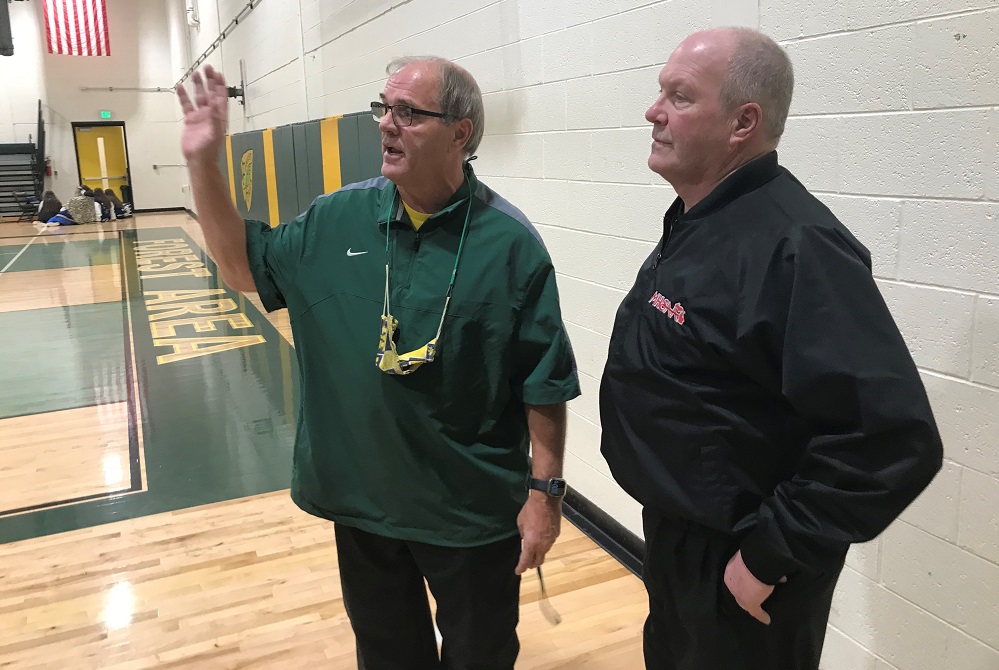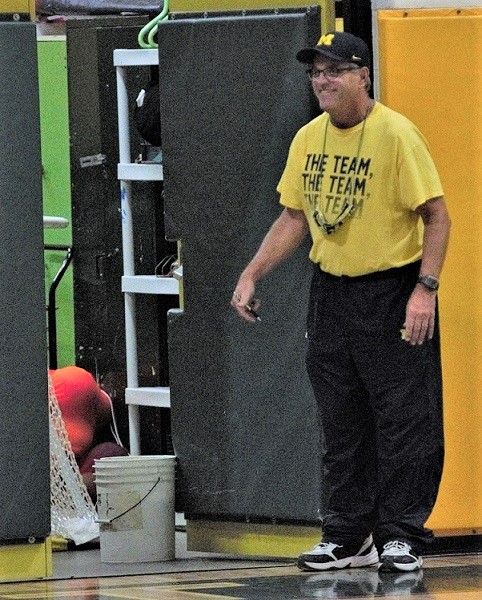
Jack Roberts, on Tom Rashid: One More Call
By
John E. (Jack) Roberts
MHSAA Executive Director, 1986-2018
December 9, 2021
More than a decade ago, with his knowledge, I placed in my “Will & Instructions Upon Death” that Tom Rashid was to be the one and only person to speak at my funeral or memorial service. A short number of years later, Tom told me that I was to do the same for him. Obviously, we knew that we could not both keep our promise to the other. But I must say, if Tom does not actually show up for my funeral, that will be the first time he has not kept a promise to me.
I understand there will be a time in the future, when the weather warms and COVID wanes, when school administrators across Michigan can gather in force to show their respects to Tom, and when I will provide the eulogy that Tom asked of me. But Tom’s recent death reminds us how uncertain life can be and suggests that I say some things now, before it’s too late.
Tom was the unparalleled master of award presentations; and for more than a dozen years he wrote and delivered polished praise on award recipients at the annual conference of the Michigan Interscholastic Athletic Administrators Association. My tribute now isn’t an awards presentation or hall-of-fame induction, so I won’t recount the particulars of Tom’s career; but what you will see here is the importance of Tom’s life … the themes that distinguish him from any other person I’ve known.
Tom comes from a large, complicated and compassionate family of parents, aunts, uncles, brothers, sisters, nephews and nieces who mourn his loss at levels few of us can fathom. Over the years, and for many years, he was the caretaker for several family members; and he was generous with all of them. My hope for each family member now – and for many days, weeks and months to come – is that you are at peace. Tom’s pain is over; and his place in eternity is secure. Tom purchased a reserved seat.
Tom often joked that his only good habit was prayer. That’s not really true, of course. But for as long as I’ve known Tom, he talked to God many times a day; and I’ve always had the feeling that he talked to God the same way he talked to us: bluntly, forcefully, passionately, honestly, loudly, making very plain what he had on his mind.
Tom was a rigorous practitioner of his devout Catholic faith; and, the God whom Tom believed in is a big God … the president, general manager and head coach of a huge, diverse team whose game plan is a large, loving Gospel of limitless parameters and possibilities. I have no doubt that, both in times of need and not, members of the Roberts family – including both my parents, my sister, my wife and our children and grandchildren – have been specific in his petitions to God. I have no doubt that Tom’s daily prayers included many of you, and your loved ones as well.
In addition to Tom’s immediate family is the even larger and even more complicated family Tom developed through a long, illustrious career in Michigan school sports administration: a full 25 years with the Archdiocese of Detroit, until 2003, when I invited him to join me at the MHSAA office in East Lansing.
During my 32 years as the executive director of the MHSAA, I never saw another like Tom … never, anywhere. He talked to anybody, anytime of the day or night, about any question or problem they might have. Usually, Tom didn’t need to give me notes reviewing his telephone conversations. From my adjacent office, and given his forceful voice, I could hear Tom’s every word, very clearly.
Tom had the ability to anticipate what I might need and take care of it without my asking. It is no exaggeration to say that Tom would do anything for me. For example, Tom’s reluctance to travel and his fear of flying are well known to many of you. I believe the one and only time that Tom flew in an airplane was in 2003, when I ordered him to fly to Texas so that he might receive the highest award of the National High School Coaches Association. He had never flown before; he has never flown since.
Most remarkable was not merely Tom’s unselfish, unlimited, legendary availability to athletic administrators at any hour of the day or night, nor his experienced, learned grasp of the subject matter in answering their calls. What was more remarkable was his effort to help school administrators through their hard times. On many occasions these callers had made an error of commission or omission. They had made a mistake or an oversight; and Tom was supremely compassionate in guiding them through the local fallout from disappointed athletes and disgruntled adults. Secure in himself and our mission to be servant-leaders, Tom very often shared or completely shouldered unjustified blame so others would not. He gave cover to countless local school administrators every year of his MHSAA career so that those administrators might survive and even thrive in their careers.
Among my remarkably loyal MHSAA staff, Tom still stands out. And he earned the enduring loyalty of those with whom he worked. I think especially of his successor at the Archdiocese of Detroit, Vic Michaels: I doubt that more than two days ever passed between their almost daily telephone conversations … usually in the morning … for the full 15 years that my office was next to Tom’s at the MHSAA. I have never, ever been witness to anything like that; and I know there is no one in our good work who misses our dear colleague more than Vic.
But most remarkable of all was Tom’s ability to turn an adversary into an ally. He could have a knock-down, drag-out argument with a person one day, and by the next day, and for years to come, that person was Tom’s greatest advocate and admirer.
Well … maybe second-greatest advocate and admirer. Because no one in athletic administration – no one – loved Tom more than I. And no one in our work told him this more than I did.
I have written often about my admiration and affection for Tom. I have spoken both publicly and privately of it, on many occasions. But let me say it one more time, here, as we celebrate his life, and mourn our loss …
Tom and I provide proof that opposites attract, and we tag-teamed MHSAA’s leadership. One of us was very outgoing and vocal, the other more reserved and reticent. One of us was loud, the other more subdued. One of us was more comfortable on the phone, the other with the pen. One of us had no idea what to do with apostrophes, while the other would put them in the correct places. One of us was more spontaneous and extemporaneous, the other a more detailed planner and measurer of consequences. One of us hated to travel, the other sent messages to him from distant oceans and continents every year on Christmas or New Year’s Day to thank him for his life and service. But in our hearts, where one’s core values are harbored, we were almost identical twins.
I doubt that any two people who were side-by-side in the workplace for 15 years expressed their gratitude for each other more than we did, nor any two co-workers who said “I love you” to one another as often as we did. We each felt in deep debt to the other for myriad gifts and gestures that improved our careers and our lives.
Over the years, Tom and I developed the strategy of making one more telephone call before we made a final decision in a difficult matter … making one more call that sometimes made a difference in the controversial decision we had to make or in how that decision was accepted by those it affected. Tom loved to be the one to make those calls. And, sometimes, that “one more call” made all the difference.
Throughout my adult life, whenever I’ve attended a funeral or memorial service, I’ve found myself asking what it is I should learn and try to emulate from the life of the deceased. If you should find your mind and heart doing anything like that now, may I suggest these two answers.
First, Tom’s life and death remind us that we should not delay a single day in telling those with whom we work that we appreciate them and are grateful for what they do. And, if it is true and you are able, say you love them. Tom did this more often than anyone I’ve known.
And the second message is this. Tom’s life stands for faithfulness … faithfulness to his God, faithfulness to his family, faithfulness to his colleagues and friends, and faithfulness to his work and the mission of not just amateur athletics, but particularly school-operated, educational athletics. His was a steadfast faithfulness, never-a-day-off faithfulness, you-come-first faithfulness.
So Tom, my dear friend, once again I say, “I love you.”
And, “Rest in peace, Tom. God knows, you rarely rested in life.”
I would give anything for just one more call.

Forest Area's Stremlow Never Far from Serving School Sports Community
By
Tom Spencer
Special for MHSAA.com
February 4, 2022
He hasn’t met a sport he can’t coach. And, he probably hasn’t turned down a team he’s met – yet.
 Many of the coaching jobs he’s taken were actually offered to him by him.
Many of the coaching jobs he’s taken were actually offered to him by him.
Whenever he’s started a new sport, he’s sought mentors in the form of successful veteran coaches. But make no mistake, if they made a movie in Northern Michigan called “The Mentor” – this Hall of Fame coach would be the star of the show.
He’s technically retired today. The teams he coaches don’t get TV cameras and other media present. He’s a middle school track and volleyball coach for Fife Lake Forest Area Community Schools.
He’s perhaps most well-known as the past volleyball coach at Forest Area. Don’t be surprised if you hear of graduated athletes – and current student-athletes – from Glen Lake, Manton, Kingsley and even McBain Northern Michigan Christian happily call him “Coach.”
Name the coach? Ron Stremlow. He’s a retired physical education teacher, athletic director and coach. He came out of retirement to return as the part-time athletic director for Forest Area, a district he served 32 years as a teacher.
He’s also coaching a couple of middle school sports, just like he did when he was working full-time. Athletic directors often need to put themselves in tough-to-fill coaching slots.
“Ron Stremlow has been a tremendous ambassador of high school sports in Northern Michigan,” said Dave Jackson, athletic director of Frankfort-Alberta Schools. “The number of coaches, parents and athletes Ron has encouraged during his years of service are too many to count.
“He is an athletic administrator that has always been about service and what (he) can do to help.”
Help is exactly what he did once upon a time for then-new volleyball coach at McBain Northern Michigan Christian, Diane Eisenga. The call for help came from Eisenga’s players.
Today, Eisenga is an athletic assistant for the Comets and mother of five boys, her youngest still attending NMC. Like Stremlow, she has built a very successful program. Back then, she was just getting started, pregnant and a mother of two children, and unable to coach her team during a Ferris State University tournament that Stremlow had planned to scout with longtime friend and Kingsley 1,000-win volleyball coach Dave Hall.
Stremlow actually was planning to watch NMC at the tournament, anticipating the Comets would be a potential roadblock to a District title that upcoming season. (He was right: Forest Area would end up losing to NMC in a District Final as the Comets reached the Class D Quarterfinals.)
 What Stremlow did not anticipate was being asked by the Comets players to step in and coach them at the Ferris tourney. Stremlow was told Eisenga was not feeling well enough to guide the team at that moment.
What Stremlow did not anticipate was being asked by the Comets players to step in and coach them at the Ferris tourney. Stremlow was told Eisenga was not feeling well enough to guide the team at that moment.
Stremlow did not hesitate to help. He had previously leant his wisdom to the former Dordt University (Iowa) athlete with tryouts, cutting decisions and NMC’s summer camp.
“I had played in high school and college, but I was green,” Eisenga acknowledged. “He was a good mentor.”
She recalls her players asking for Stremlow’s help.
“I got real light-headed and wasn’t feeling well,” she said. “Because the girls had known him, he took over for me that day.”
It wasn’t a surprise for Eisenga to witness Stremlow’s contribution to her team’s success that year.
“I always saw him as more of a mentor and more of a friend (than an opposing coach),” Eisenga said. “He was happy with anyone’s success.
“He was always happy for any team that played well,” she continued. “Of course, he always wanted his own to win. … He was always respectful, and you never saw him cross the line.”
Stremlow, who jokes about maybe not having the most wins among hall of fame volleyball coaches while claiming the most losses amongst the elite group (he still ranks 17th in MHSAA history with 944 volleyball wins despite retiring from the Forest Area varsity after the 2018 season), spends his days taking care of Forest Area boys and girls basketball, completive cheer and the Warriors co-ed wresting teams. Many a night he does whatever it takes to run an event, including running the scoreboard for basketball.
In the fall, Forest Area offers 8-player football, cross country and volleyball. He’s in the midst of finalizing spring softball, track and baseball.
Basketball is perhaps his favorite sport, but he loves the change of seasons.
“Once that season’s up, I am ready to rock and roll and get into another,” Stremlow noted.
Giving back is what keeps the 62-year-old Stremlow going. He sees at least three years of involvement ahead.
“A lot of kids do not get good role models or good coaches. And I thought if I can help kids out, I am going to,” Stremlow said.
Today Stremlow wears many school colors, especially the Warriors’ forest green. You also often can find him in Kingsley orange, or perhaps it is actually the Manton orange.
You will definitely find him in his favorite, maize and blue. His forest green should never be confused with the Michigan State green. The Wolverines became the favorite of the Central Michigan grad when he got into the Big House as a high school student with a $2 ticket to watch Michigan take on Navy.
“I have green, but it is not the Michigan State green,” Stremlow said he often jokes with fans of the Spartans and Warriors.
Stremlow uses all his team colors as he follows another passion, photography. He got a camera for college graduation, and student-athletes all over Northern Michigan have benefited.
“There are thousands of former players from Forest Area and Kingsley that can point to pictures in their homes that Ron has taken of them playing sports,” Jackson said. “These pictures are not just cute shots, but pictures that were used to teach form and techniques.”
Stremlow takes satisfaction from capturing sports on film, rather digitally, as he does today.
“I take a lot of pictures – I‘ve always liked it,” he said. “That’s the best gift you can give any kid and parents – just getting pictures.
“It really helps, plus I like doing it.”
 Tom Spencer is a longtime MHSAA-registered basketball and soccer official, and former softball and baseball official, and he also has coached in the northern Lower Peninsula area. He previously has written for the Saginaw News, Bay County Sports Page and Midland Daily News. He can be reached at [email protected] with story ideas for Manistee, Wexford, Missaukee, Roscommon, Ogemaw, Iosco, Alcona, Oscoda, Crawford, Kalkaska, Grand Traverse, Benzie, Leelanau, Antrim, Otsego, Montmorency, Alpena, Presque Isle, Cheboygan, Charlevoix and Emmet counties.
Tom Spencer is a longtime MHSAA-registered basketball and soccer official, and former softball and baseball official, and he also has coached in the northern Lower Peninsula area. He previously has written for the Saginaw News, Bay County Sports Page and Midland Daily News. He can be reached at [email protected] with story ideas for Manistee, Wexford, Missaukee, Roscommon, Ogemaw, Iosco, Alcona, Oscoda, Crawford, Kalkaska, Grand Traverse, Benzie, Leelanau, Antrim, Otsego, Montmorency, Alpena, Presque Isle, Cheboygan, Charlevoix and Emmet counties.
PHOTOS (Top) Fife Lake Forest Area athletic director Ron Stremlow talks with official Chuck Bott (right) before a basketball game against Indian River Inland Lakes this season. (Middle) Stremlow shows support for his favorite college team while prepping before a game against Johannesburg-Lewiston. (Top photo by Tom Spencer; middle photo by Andrew Fish/Gaylord Herald-Times.)

